Hassle-free automated attendance system
Jun 6, 2024
Jun 6, 2024
Jun 6, 2024


The attendance sheet conundrum
Imagine sifting through piles of attendance sheets, trying to decipher each student's unique handwriting. It's a tedious and time-consuming task, prone to errors and inconsistencies. Traditional attendance tracking methods often lead to frustration for teachers and administrators alike.
Enter OCR (Optical Character Recognition) technology, a game-changer in the world of attendance tracking. With OCR, recognizing and processing handwritten text becomes a breeze, making the entire attendance tracking process more efficient, accurate, and hassle-free. In this blog, we'll explore how OCR can revolutionize attendance systems by seamlessly converting handwritten text into digital records.
( Please note all the names mentioned in the figures are made up)
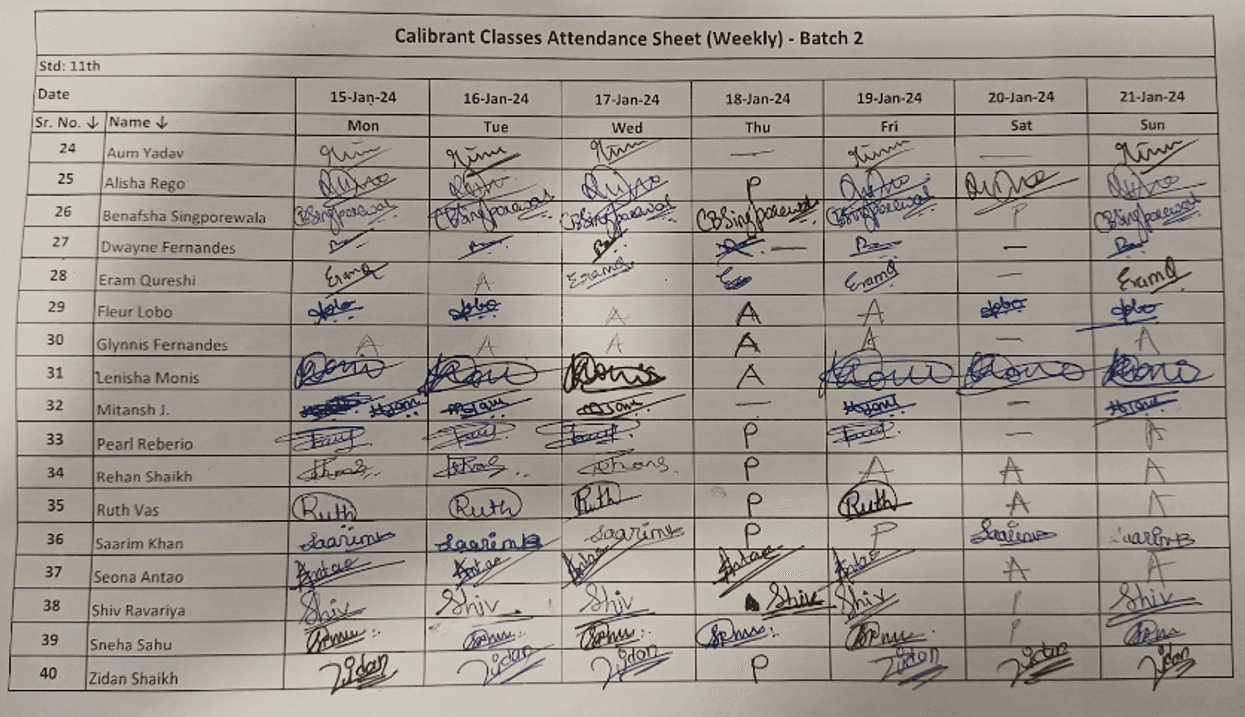
(Fig 1)
Fig 1 shows us how the students have manually filled the attendance sheet
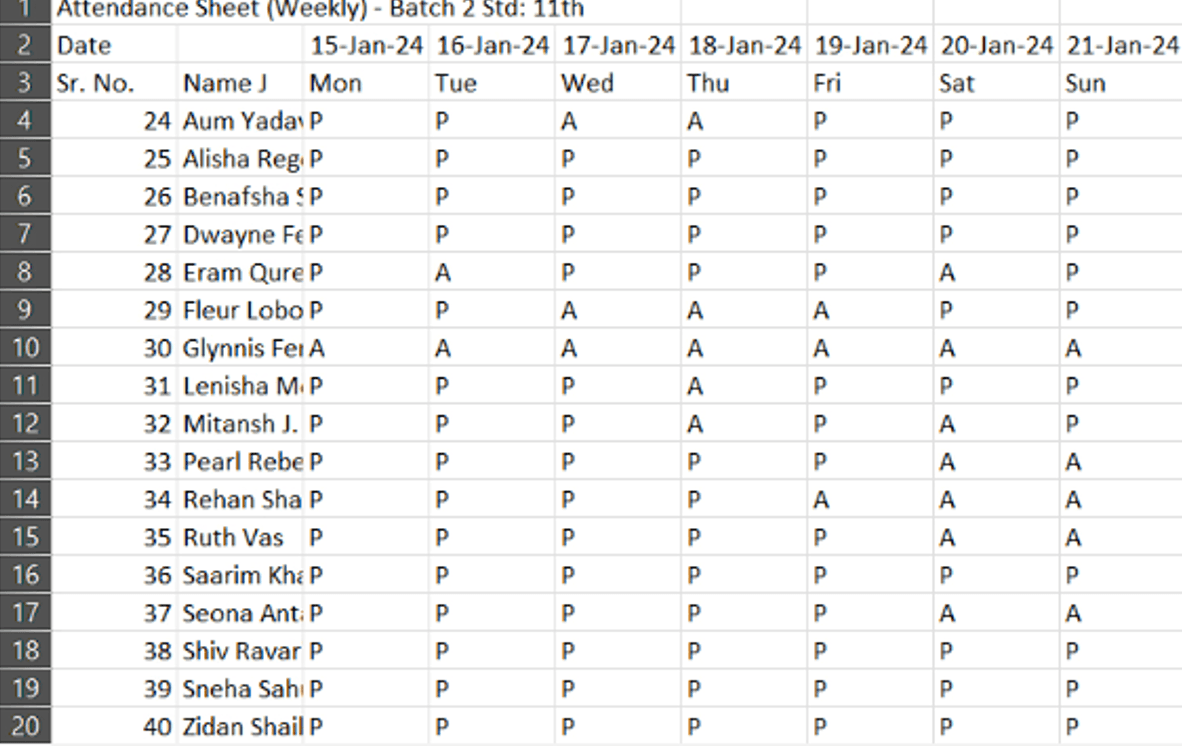
(Fig 2)
Fig 2 shows us how the admins have manually converted it into an excel sheet
The Need for Automation
Recognizing this pain point, we decided to streamline this process and revolutionize attendance tracking. Leveraging the power of machine learning, optical character recognition (OCR) and traditional algorithms, we set out to develop a one-click solution that eliminates the need for manual data entry and digitizes attendance sheets with unprecedented speed and accuracy.
Architecture Diagram
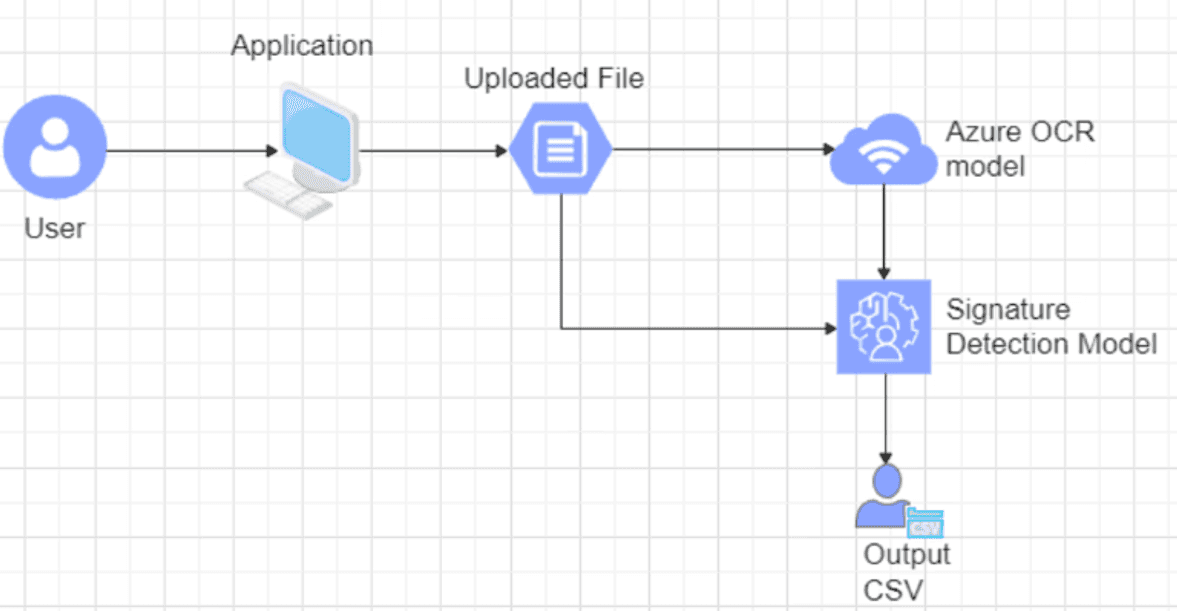
(Fig 3)
As shown in the architecture diagram, the system first takes the input from the user and then it uses a hybrid of Azure OCR model and the custom created signature detection model and then gives us the output as csv
Machine-Generated Text vs. Handwritten Text
Our solution harnesses the capabilities of machine learning models, such as the Azure ML Form Recognizer API, to achieve superior accuracy in text recognition. Through extensive testing and validation, we've observed that machine-generated text consistently outperforms handwritten text or signatures present in the attendance sheet in terms of accuracy and reliability. Where a computer generated or printed text is transcribed with an almost 100% accuracy.
Quick Demo on Accuracy and Challenges
Benefits of OCR
By automating the transcription process, this solution offers several key benefits, including:
Faster processing times
Eliminate human errors
Increased efficiency and productivity for educators and administrators
Challenges of Handwritten Signatures
While OCR technology excels in transcribing printed text with high accuracy, it often encounters difficulties when deciphering handwritten signatures. In attendance tracking scenarios, where signatures play a critical role, relying solely on OCR may not suffice due to its limitations in accurately recognizing handwritten content.
Input image:
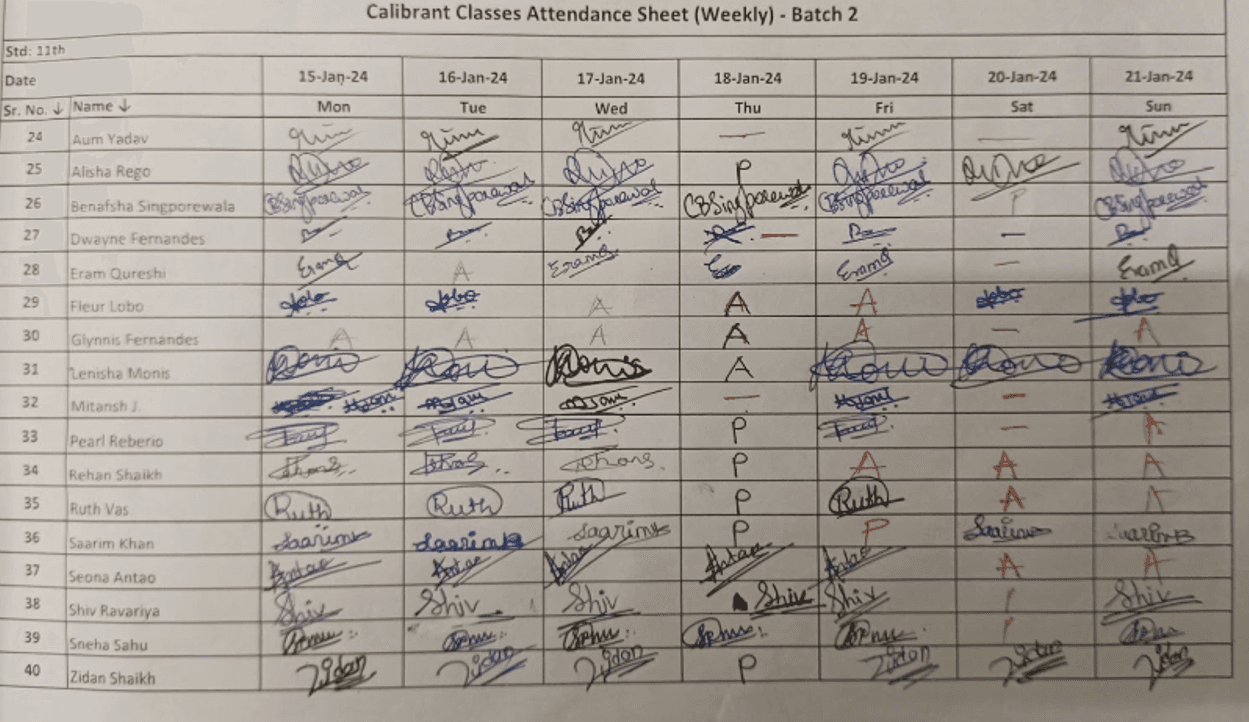
(Fig 4)
Fig 4 show us the attendance sheet manually signed by the students
Output image
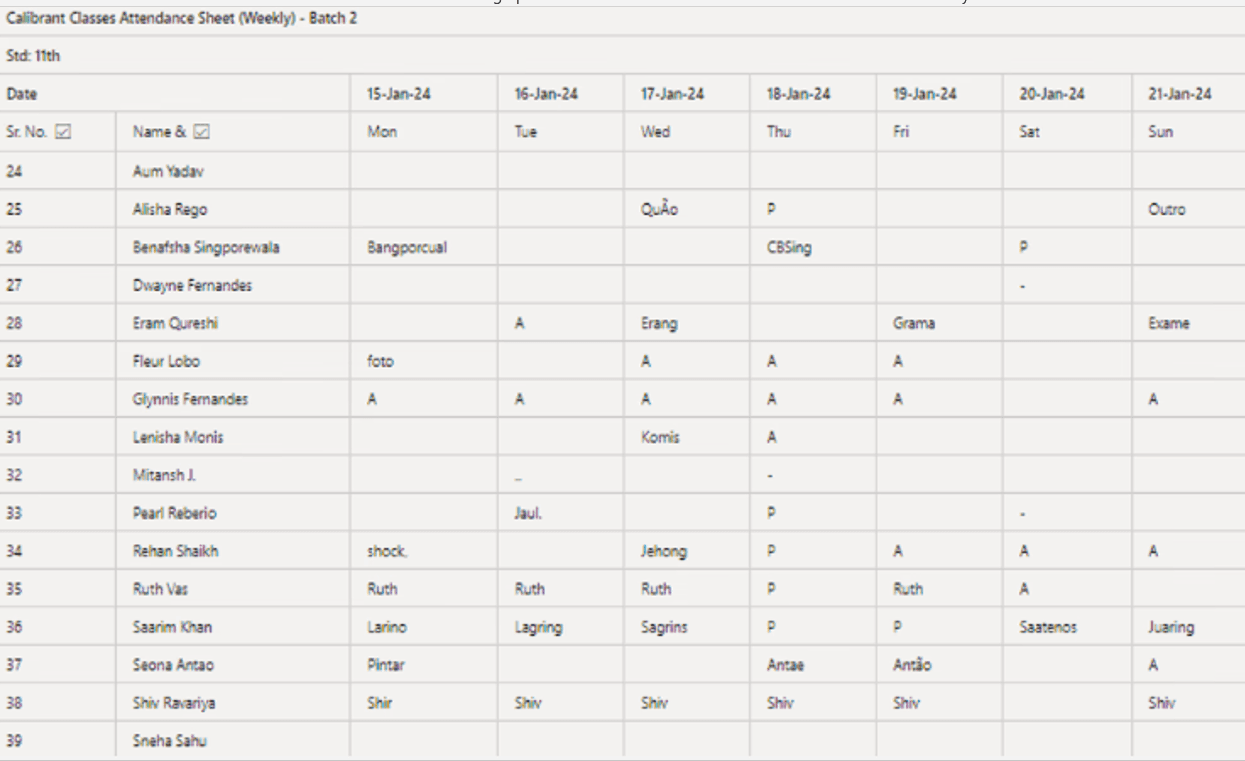
(Fig 5)
Fig 5 show us the sheet that has been converted to an excel sheet using OCR
The Need for a Hybrid Approach
While OCR technology provides a robust foundation for text recognition, as discussed above, it's not without limitations, particularly when it comes to deciphering handwritten signatures and ambiguous markings. To overcome these challenges, we've adopted a hybrid approach that combines OCR with traditional algorithms for enhanced accuracy and versatility.
Benefits of Hybrid Approach:
Improved accuracy in handling diverse data types
Greater flexibility in accommodating variations in handwriting styles and formats
Enhanced reliability through redundancy and error correction mechanisms
Our solution seamlessly integrates OCR by using contour analysis techniques to extract data from attendance sheets cells where OCR fails to extract any. By intelligently combining these methods, we're able to accurately identify text, signatures, and blank cells, ensuring comprehensive coverage and minimal errors in the digitization process.
Quick Demo on Hybrid Approach
Model performance
Comprehensive testing has shown that the precision stands at around 95%, with the remaining 5% being ascribed to outlier scenarios that can be easily sidestepped, given that the cells were inadvertently filled by students under adverse conditions.
Although our solution demonstrates commendable accuracy, it's crucial to recognize potential constraints and hurdles. Variables like image clarity, illegible handwriting, and adversarial annotations on the layout may influence performance, leading to sporadic inaccuracies. Nevertheless, through continuous enhancement and fine-tuning, we are dedicated to mitigating these challenges and ensuring a smooth user experience.
Pricing
Our current expenses for this use case are negligible, as the API offers 500 free calls per month and incurs charges only when we surpass this limit. Since attendance generation occurs just once at the week's end, this approach is essentially cost-free, with the sole expenditure being the funds required to operate the pre and post-processing algorithms on users' PCs. The costing after or when you exceed the free limit ends up being only 10$ per 1000 pages of instances ram.
Conclusion
In conclusion, our automated digital solution offers a transformative approach to attendance tracking, empowering educators and administrators with speed, accuracy, and efficiency.
Whether you're managing a classroom or overseeing a college campus, our solution simplifies the process and frees up valuable time for more meaningful tasks. Explore our open-source code today and join us in making attendance management an effortless job.
The attendance sheet conundrum
Imagine sifting through piles of attendance sheets, trying to decipher each student's unique handwriting. It's a tedious and time-consuming task, prone to errors and inconsistencies. Traditional attendance tracking methods often lead to frustration for teachers and administrators alike.
Enter OCR (Optical Character Recognition) technology, a game-changer in the world of attendance tracking. With OCR, recognizing and processing handwritten text becomes a breeze, making the entire attendance tracking process more efficient, accurate, and hassle-free. In this blog, we'll explore how OCR can revolutionize attendance systems by seamlessly converting handwritten text into digital records.
( Please note all the names mentioned in the figures are made up)

(Fig 1)
Fig 1 shows us how the students have manually filled the attendance sheet

(Fig 2)
Fig 2 shows us how the admins have manually converted it into an excel sheet
The Need for Automation
Recognizing this pain point, we decided to streamline this process and revolutionize attendance tracking. Leveraging the power of machine learning, optical character recognition (OCR) and traditional algorithms, we set out to develop a one-click solution that eliminates the need for manual data entry and digitizes attendance sheets with unprecedented speed and accuracy.
Architecture Diagram

(Fig 3)
As shown in the architecture diagram, the system first takes the input from the user and then it uses a hybrid of Azure OCR model and the custom created signature detection model and then gives us the output as csv
Machine-Generated Text vs. Handwritten Text
Our solution harnesses the capabilities of machine learning models, such as the Azure ML Form Recognizer API, to achieve superior accuracy in text recognition. Through extensive testing and validation, we've observed that machine-generated text consistently outperforms handwritten text or signatures present in the attendance sheet in terms of accuracy and reliability. Where a computer generated or printed text is transcribed with an almost 100% accuracy.
Quick Demo on Accuracy and Challenges
Benefits of OCR
By automating the transcription process, this solution offers several key benefits, including:
Faster processing times
Eliminate human errors
Increased efficiency and productivity for educators and administrators
Challenges of Handwritten Signatures
While OCR technology excels in transcribing printed text with high accuracy, it often encounters difficulties when deciphering handwritten signatures. In attendance tracking scenarios, where signatures play a critical role, relying solely on OCR may not suffice due to its limitations in accurately recognizing handwritten content.
Input image:

(Fig 4)
Fig 4 show us the attendance sheet manually signed by the students
Output image

(Fig 5)
Fig 5 show us the sheet that has been converted to an excel sheet using OCR
The Need for a Hybrid Approach
While OCR technology provides a robust foundation for text recognition, as discussed above, it's not without limitations, particularly when it comes to deciphering handwritten signatures and ambiguous markings. To overcome these challenges, we've adopted a hybrid approach that combines OCR with traditional algorithms for enhanced accuracy and versatility.
Benefits of Hybrid Approach:
Improved accuracy in handling diverse data types
Greater flexibility in accommodating variations in handwriting styles and formats
Enhanced reliability through redundancy and error correction mechanisms
Our solution seamlessly integrates OCR by using contour analysis techniques to extract data from attendance sheets cells where OCR fails to extract any. By intelligently combining these methods, we're able to accurately identify text, signatures, and blank cells, ensuring comprehensive coverage and minimal errors in the digitization process.
Quick Demo on Hybrid Approach
Model performance
Comprehensive testing has shown that the precision stands at around 95%, with the remaining 5% being ascribed to outlier scenarios that can be easily sidestepped, given that the cells were inadvertently filled by students under adverse conditions.
Although our solution demonstrates commendable accuracy, it's crucial to recognize potential constraints and hurdles. Variables like image clarity, illegible handwriting, and adversarial annotations on the layout may influence performance, leading to sporadic inaccuracies. Nevertheless, through continuous enhancement and fine-tuning, we are dedicated to mitigating these challenges and ensuring a smooth user experience.
Pricing
Our current expenses for this use case are negligible, as the API offers 500 free calls per month and incurs charges only when we surpass this limit. Since attendance generation occurs just once at the week's end, this approach is essentially cost-free, with the sole expenditure being the funds required to operate the pre and post-processing algorithms on users' PCs. The costing after or when you exceed the free limit ends up being only 10$ per 1000 pages of instances ram.
Conclusion
In conclusion, our automated digital solution offers a transformative approach to attendance tracking, empowering educators and administrators with speed, accuracy, and efficiency.
Whether you're managing a classroom or overseeing a college campus, our solution simplifies the process and frees up valuable time for more meaningful tasks. Explore our open-source code today and join us in making attendance management an effortless job.